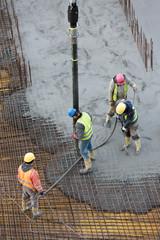Hiring a professional deck builder can save you money in the long run. Pro Deck Builders Charleston will help you avoid costly mistakes and repairs that can arise from a poorly designed or constructed deck. Narrow down your contractors by asking about their experience with the type of deck you want to build. It can be done by conducting phone interviews or emailing photos to gauge their experience level.

Professional deck builders specialize in designing and constructing outdoor living spaces, and they have the expertise to build your dream deck. They will consider factors such as load-bearing requirements, durability considerations, and aesthetics to create a unique deck design that complements the architecture of your home and meets your lifestyle needs. They can also advise you on the best materials and construction techniques to ensure your deck is safe and durable.
Professionals are skilled craftsmen who have honed their skills through years of experience, so they can work more efficiently and effectively than you can on your own. Additionally, they have established relationships with vendors, which may help them save you money on materials and reduce overall project costs. Furthermore, they adhere to strict quality standards, which can result in a sturdy, attractive deck.
A well-designed and built deck can transform an ordinary yard into a backyard oasis where you can enjoy a barbecue or spend a relaxing afternoon with family or friends. It can also add value to your property and become an appealing selling point if you sell your home. Professional deck builders can bring your vision to life and create a custom outdoor living space that will envy the neighborhood.
When choosing a deck contractor, it is important to research your options and select one with a good reputation. Reading online reviews and asking friends, family, and neighbors for recommendations can help narrow your choices. Moreover, it would be best to ask contractors for references and a portfolio of previous projects to assess their artistry. Lastly, looking for a contractor who offers a warranty on their services would be best.
When you hire a contractor, you want to know they can deliver the results you expect. The best way to gauge a company’s reputation is through past client reviews and experience. A trusted deck builder will be able to provide you with a list of previous projects, along with photos and testimonials from satisfied customers. It will give you a clear picture of the type of work they perform and the level of satisfaction that their clients experience.
A professional custom deck builder is familiar with local regulations and building codes, so you can rest assured that your new deck will be safe and comply with all applicable standards. In addition, they will help you navigate the logistics of obtaining necessary permits and HOA approvals. It will allow you to save time and avoid costly delays.
Another advantage of working with a professional deck builder is their attention to detail. They will look at every aspect of your project, from the big picture to the smallest details. They will ensure that the finished product meets your high-quality specifications.
Adding a deck is a great way to increase your home’s value and curb appeal. With some planning, you can transform a dull backyard into an oasis for outdoor living. Whether you want to entertain guests or enjoy a cool evening outdoors, a professionally designed deck can make all the difference. A trusted deck builder can help you create a space you and your loved ones will enjoy for years. To learn more, contact us today! We would love to help you with your next outdoor project.
When working with a professional deck builder, you can expect their work to be done on time and per your specifications. They will be able to provide you with estimates and design ideas that will help you choose the best deck for your home. It will allow you to get the best value for your money and create a beautiful outdoor space you can enjoy with family and friends. A reputable deck builder will have excellent communication skills and will always keep you updated on the progress of your project. They will also treat you and your property courteously and professionally throughout the process.
In addition to their expertise and experience, professional deck builders offer quality craftsmanship and attention to detail, ensuring your new deck is durable and aesthetically pleasing. They can also handle the entire construction process, including obtaining the necessary permits, sourcing high-quality materials, and executing the project precisely and efficiently. They can also take a variety of different types of projects, including ground decks, upper decks, and even roof decks.
A reputable deck builder will be licensed and insured. It will protect you from any unforeseen issues arising during or after construction. They will also be able to address any problems promptly, demonstrating their commitment to customer satisfaction. In contrast, unlicensed contractors are less likely to respond to customer concerns quickly.
When choosing a deck builder, ask about their past projects and read online reviews. These will help you whittle down your list of potential candidates. It is also a good idea to meet with your possible contractor face-to-face so that you can discuss the details of your project. It will also give you a better sense of their personality and style.
Decks are outside, which means they are exposed to the elements and can be affected by many environmental factors. It is a good idea to have a professional inspection to ensure the safety of your deck before summer rolls around. It is easy to miss small things that can cause major damage to a balcony, but an experienced pro will be able to spot the problems and fix them.
One of the most important considerations when building a new deck is positioning it in a way that will give you the most enjoyment. Choosing the right location will allow you to take advantage of natural features like a beautiful view or abundant sunlight. It would be best to consider how the deck will be used and what activities you plan on doing.
It would be best if you regularly inspect your deck for signs of deterioration or damage and keep up with regular cleaning and maintenance. For example, if you notice excessive flaking or chipping of the paint on your deck, it may be a sign that the wood is rotting underneath. If not addressed, the deck could collapse and cause injury or property damage.
Another important step is ensuring your deck complies with local codes and regulations. An experienced deck builder will know the ins and outs of local codes and can build your deck according to specifications. In addition, they can pull the required permits and ensure that all safety requirements are met. It will prevent you from getting into legal trouble if something goes wrong with your deck in the future.
Licensed builders follow stringent safety standards and protocols to ensure your deck is safe. They also have the expertise to address any structural issues that may arise during construction, protecting you from liability. In contrast, unlicensed contractors may lack insurance coverage, leaving you vulnerable to costly fines or legal action.
Choosing a pro deck builder for your project will help you avoid the many common mistakes homeowners make when trying to do it themselves. These mistakes can be expensive and dangerous, so hiring a professional is the best way to ensure your deck is built correctly and safely.
Professionals have a keen eye for detail and can spot potential problems before they occur. It helps prevent expensive errors and ensures your deck is long-lasting and beautiful. They can also provide you with a warranty on their work, which gives you peace of mind that the job will be completed properly and on time.
A deck builder with extensive manufacturer training will assess your preferences’ feasibility. It means they are familiar with all aspects of the deck-building process and can provide you with a seamless, stress-free experience. They are also committed to customer service and will work closely with you to meet your unique needs. In addition to their technical knowledge, they can offer valuable advice on maintaining your deck and keeping it looking great for years to come. They also know about local climate conditions and terrain, which can affect the construction process. They can recommend the best materials for your area, ensuring your deck is safe and durable.





